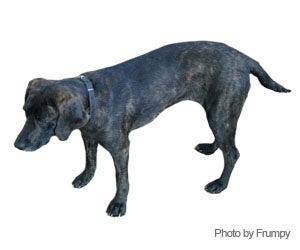Plott
-
Overview
The Plott is a hard-working hunting dog who is still used to hunt big game and tree smaller animals. Their powerful hunting skills helped make them the state dog of North Carolina, where they are used as coonhounds. Plotts range in size from 40 to 60 pounds and stand about 20 to 25 inches tall.
For experienced owners who are looking for an active dog who loves to spend time exploring outdoors, the Plott makes an intelligent, hard-working companion. These dogs make excellent, loyal pets for owners who can provide them with plenty of space to run and hunt and are able to commit lots of time to consistent, firm training.
-
Personality
-
Coat Care

The Plott's short coat does not shed, but it should be run through with a rubber brush to maintain its texture and shine.
Plotts need to be bathed somewhat frequently, especially if they are primarily outdoor dogs. Bathe them with gentle dog shampoo to make sure their coat stays glossy and retains its natural oils.
Clipping or trimming your dog’s coat is far easier than you would ever imagine. With the right clipper, trimmer and scissors, giving your dog a haircut is easy on your wallet and your schedule.
Dogs with smooth coats generally only require trims and tidying up in areas of excessive hair growth using a trimmer or blunt scissors. It's always wise to take a dog for a short walk or exercise to calm them down before trimming. Remember to brush the coat first to remove any tangles and mats. Don't forget to trim around the paws, pads, tail, chest and sanitary areas, as needed. The coat should lay flat and smooth against the body when finished.
Many dog owners are apprehensive about trimming their dog’s nails because they are nervous about cutting into the quick. But with the right conditioning and careful cutting, nail clipping can be a simple, stress-free activity for you and your dog.
Provide your dog with plenty of positive reinforcement and even treats to help associate nail clipping with a positive experience. As you start to clip, gently press on your dog’s paws to help him become accustomed to the feeling of having his nails clipped. Then, work gradually, shaving down just a thin portion of the nail at first to make sure you don’t reach the quick. Clip one nail, reward your dog with a treat, and stop to give him some positive reinforcement before moving on. Gradually increase the number of nails you clip in one sitting to help your dog get used to the process. Never trim extremely long nails down to a short nail in one sitting, because this is an excellent way to accidently quick the dog’s nail. Instead, work gradually, shaving small portions of your dog’s nails off each time.
You can tell if you’re getting close to the quick by the texture of your dog’s nail. The nail is hard closer to the surface and becomes softer as you get closer to the quick. If your dog’s nail starts to feel softer, that’s a good indication that you’re getting close to the quick.
Plott's ears need to be cleaned regularly and checked for infection. Their floppy ears can block circulation and water, which can cause painful infections.
Many owners do not realize how important it is to brush your pet’s teeth on a regular basis. Some dogs are prone to dental problems and sensitive teeth, especially small dogs with tiny teeth and dogs with special diets. These problems can be easily combatted with frequent brushing.
Cavities are rare with dogs but gum disease caused by tartar buildup is not, which is why they require regular brushing with toothpaste and a toothbrush formulated specifically for dogs. While daily brushing is ideal, doing so on a weekly basis will be a big help in avoiding the need to bring your dog to a veterinarian for a cleaning, which usually has to be done under sedation.

 India (English)
India (English)
 Middle East and Africa (English)
Middle East and Africa (English)
 South Africa (English)
South Africa (English)
 Australia (English)
Australia (English)
 Japan (日本語)
Japan (日本語)
 South East Asia (English)
South East Asia (English)
 Singapore (English)
Singapore (English)
 Europe (English)
Europe (English)
 United Kingdom (English)
United Kingdom (English)
 Argentina (Español)
Argentina (Español)
 Brazil (Portuguese)
Brazil (Portuguese)
 Colombia (Español)
Colombia (Español)
 Latin America (Español)
Latin America (Español)
 México (Español)
México (Español)
 Chile (Español)
Chile (Español)
 Peru (Español)
Peru (Español)
 Canada (English)
Canada (English)

